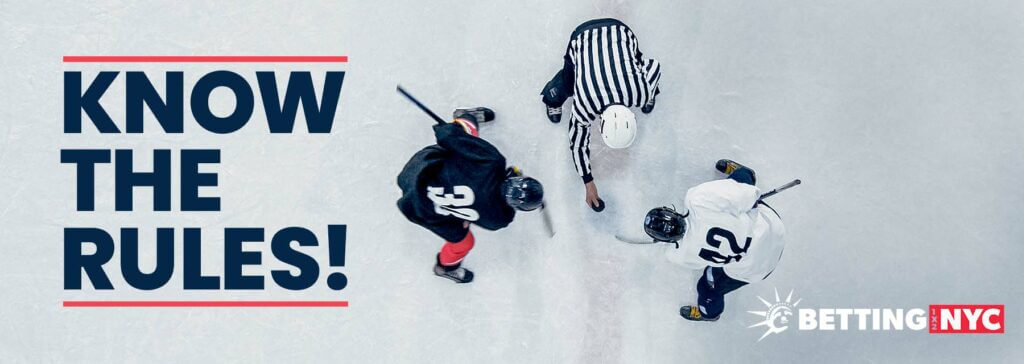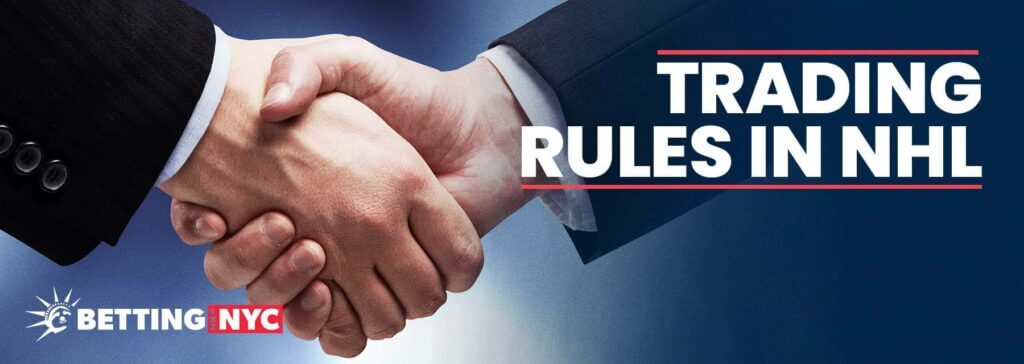The Importance of Understanding NHL Rules

Our NHL experts are well-versed in the game and appreciate the relevance of understanding these rules when placing profitable wagers.
If you’re looking for a refresher, check our in-depth guides on NHL betting odds and teams, or keep reading for a detailed look at the NHL rules.
NHL – What is the Main Objective?
The game’s objective is to get the puck over the other team’s goal line and defend your goal line to stop the other team from scoring.
The winning team is the one that scores the most points at the end of regular time. If the game is tied, it moves into overtime and then a shootout.
Ice Rink, Scoring & Roles
There are standards that must be met by each rink that hosts NHL games. An NHL ice rink, as defined by league regulations, must be at least 200 feet long and 85 feet wide.
Even the corners must fall inside a certain arc range with a 28-foot radius. The ice rink is partitioned into three main zones:
- Neutral Zone
- Defensive Zone
- Offensive Zone
There are also various markings found within each zone:
- Neutral Zone
- Face-Off Circle
- Face-Off Dots
- Defensive/Offensive Zones
- 2 x Face-Off Circles
- Goal Line
- Goal / Net
- Crease
- Trapezoid
How to Score
A goal is scored when a player successfully directs the puck over the other team’s goal line. While they can’t use their hands, they can use any other of their body parts or their stick.
A goal is only counted if the whole puck crosses the goal line.
“Pro leagues like the NHL install a sensor to determine when a puck has passed the goal line.”
NHL Team Player Roles
NHL hockey teams consist of a roster made up of 23 players, although only 20 players can be made available for each game, and only six can be active on the ice at any one time:
- Goalie
- Right Defence
- Left Defence
- Right Wing
- Left Wing
- Centre
NHL Gameplay Fouls & Stoppages
Ice hockey has many minor and major fouls that can be committed, each with differing consequences. Below you can see the most common fouls and reasons for stoppages:
- Non-Penalty – icing, offsides, hand passes
- Minor Penalty – tripping, diving, roughing
- Major Penalty – excessive boarding, roughing, fighting
Game Time, NHL Playoff Overtime Rules & Shootouts
A typical NHL game is split into three 20-minute halves separated by brief periods of rest, as stated on the league’s official website.
These timeouts may go on for up to 15 minutes in most games and up to 17 minutes if the game is broadcast on television.
NHL Overtime Rules

All NHL games must have a winner, meaning overtime is often played to determine the winning team. There are special NHL overtime rules for the regular season and the playoffs so we will explain those key differences now.
Regular Season – NHL OT rules
- Three-on-three hockey is played for the extra five minutes.
- The sudden-death style of overtime means that the first team to score wins.
- If no one scores in the first five minutes, the game moves to a shootout.
- For the first three rounds of the shootout, each team chooses three shooters.
- Each of the teams will shoot once per round.
- The game is won by the team that has scored the most goals after three rounds.
- If both sides score three goals, the shootout continues until one side wins.
Playoffs – NHL OT Rules
- In the event of a tie, a further 20 minutes of 5-on-5 overtime will be played.
- Again, it’s sudden death, so whichever team scores first will win.
- In the event of a scoreless first overtime session, play will continue into a second, then a third, and so on, until a winner is determined.
“The longest-ever NHL game recorded was decided in the 9th period, after 176 minutes of game time between Montreal and Detroit.”
NHL Shootout Rules
First, the rules for every penalty are:
- The shooter must start from behind the middle blue line.
- Once a player touches the puck, it must keep going toward the goal.
- The penalty ends if the puck stops moving or moves backward.
- One penalty shot is allowed (therefore, no rebounds).
- Goalies can’t throw objects during penalties.
NHL shootout rules:
- Each team has three scoring chances.
- If one side scores more goals on these three shots, they win the game.
- If both teams score the same number of goals, the sudden death rounds keep going until one team has scored and the other does not.
NHL Rules for Players & Coaches
We have already worked through many of the important ice hockey laws, from the gameplay stoppages to NHL playoff overtime rules.
But some rules define what the players must do during the all-important face-off after penalties, goals, and icing.
Face-Off Rules
Face-offs help bring the puck back into play fairly and initiate each period. The center players usually take the face-off, although additional players may play if required or if team strategy dictates it.
Once the puck is in play, other players can’t approach the face-off circle within 15 feet.
Five seconds are given until the puck touches the ice, regardless of whether any player is ready. If the face-off is in the neutral zone, the away team puts their stick down first; otherwise, the relevant defending team must do so.
NHL Coach Rules
NHL coach rules are constantly changing. The topic that generates the most discussion is the coach challenges.
A coach can dispute a goal if it originated from an offside play, a missed call that should have stopped the play, or goalkeeper interference.
As it stands, the referee uses video technology to review any challenged goals or no goals, and if the coach is mistaken, his side receives a minor penalty (standard 2 minutes).
NHL Trading Rules

Teams cannot trade players with one another using cash deals. For a trade to take place, two teams must swap either players or draft selections; however, one club may keep some of the exchanged player’s salary.
In the NHL, trades often fall into one of three categories:
- Trading a member of Team A for a member of Team B.
- A player is exchanged for a draft pick.
- Multiple players or draft selections are exchanged for multiple players or draft selections.
Other Key Trading Points
Several NHL trading conditions are now being introduced that have the potential to alter a deal if a specific event occurs.
Most of these are in place to help teams ensure they don’t miss out on the best draft picks. Some of the more prominent conditions include:
- If a traded player makes the Conference or Stanley Cup, the 4th round pick will become a 3rd round pick.
- If the player traded plays at least 50% of the regular season and postseason games, the 3rd round pick will become a 2nd round pick.
- If the traded player scores upwards of 20 goals, the 3rd round pick becomes a 2nd round pick.
New NHL Rules
The NHL committee discusses and amends regulations to promote safety and fairness throughout the season and playoffs.
New NHL rules encourage rinkside video technology and player protection. It’s helpful to stay up with these developments in case anything affects the betting markets or your in-play betting chances.
Recent Rule Changes
- Rinkside video assist before penalties are awarded.
- Players leave the ice if their helmet is lost during specific plays.
- Stricter actions on cross-checking.
- Referees revoking major penalty decisions.
Other Essential NHL Rules to Remember
Some of the other key details to remember when betting on the NHL include equipment, fouls, and understanding the level of power the referees and officials hold throughout the game.
NHL Equipment
The physicality of the NHL results in a strict list of equipment that all players on the ice must meet. The main items include:
- Leather skates built to the correct standards.
- Sturdy helmets for added protection.
- Elbow and shoulder pads.
- Hockey stick and full protective gloves.
- Well-fitted mouthguard
- Correct team kit.
Referee Duties
NHL games have two refs and two linesmen, and these officials must follow strict NHL rules while maintaining order and the game’s laws.
Referees drop the puck, call penalties, and start face-offs while collaborating with both linesmen to examine any on-ice video evidence before making any final calls.
The linesmen are also responsible for running face-offs, breaking up confrontations and altercations, and alerting officials to suspected rule violations.